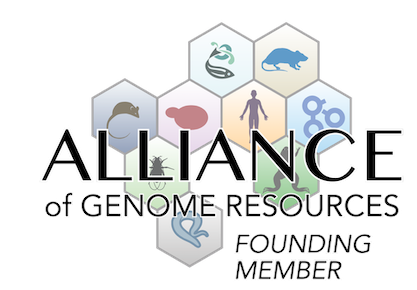Phenotypes associated with this allele
|
|
| Find Mice |
Using the International Mouse Strain Resource (IMSR)
Mouse lines carrying:
Bcciptm1d(EUCOMM)Hmgu mutation
(0 available);
any
Bccip mutation
(22 available)
|
|
|
mortality/aging
|
|
• no homozygous newborn pups are recovered; embryos are inviable at E10.5
• however, mosaic mice containing one allele of floxed Bccip that failed to complete Cre-mediated recombination are viable
|
|
|
| Find Mice |
Using the International Mouse Strain Resource (IMSR)
Mouse lines carrying:
Bcciptm1d(EUCOMM)Hmgu mutation
(0 available);
any
Bccip mutation
(22 available)
|
|
|
mortality/aging
|
N |
• mice with heterozygous or mosaic Bccip deletion are viable
|
neoplasm
|
|
• 1 of 34 heterozygous mice develop hepatocellular carcinomas (HCCs) staining positive for CD34 (an HCC marker of endothelial cells in the sinusoidal spaces) and GPC3 (glypican 3, an HCC marker in tumor cells) between 72 and 81 weeks of age
• in addition, 2 of 10 mice with mosaic Bccip deletion develop HCCs; BCCIP protein levels in mosaic tumors are decreased compared with normal liver tissues of heterozygous mice
• liver tumor masses are large, all with defined boundaries, and show loss of normal liver architecture, such as basic liver lobules with portal areas; large nucleoli and irregular nuclear contours are observed
• 2 of 3 liver tumor tissues analyzed show accumulation of insoluble p62 and increased levels of polyubiquitinated proteins, suggesting accumulation of unfolded proteins
|
|
|
• immunohistochemistry for proliferation marker Ki-67 shows more Ki-67+ cells in the liver tumor regions than in the non-tumor region
|
|
|
• 7 of 34 heterozygous mice develop lymphomas staining negative for CD3 (T-cell marker) but positive for CD45R/B220 (B-cell lymphoma marker) between 72 and 81 weeks of age
• in addition, 2 of 10 mice with mosaic Bccip deletion develop lymphomas
• all lymphoma masses are found in the abdomen, including large lymphomas adjacent to the mesentery and others adjacent to pancreases, fat pad, or abdomen wall
|
liver/biliary system
|
|
• 7 of 34 heterozygous mice show liver inflammation and necrosis
• in addition, 2 of 10 mice with mosaic Bccip deletion exhibit liver inflammation and necrosis
|
|
|
• 11 of 19 mice with heterozygous or mosaic Bccip deletion develop non-alcoholic steatohepatitis (NASH)-like pathology -- defined as the presence of both ballooning hepatocytes and cytoplasmic protein aggregates -- in non-tumor liver tissues between 72 and 81 weeks of age
|
|
|
• 11 of 19 mice with heterozygous or mosaic Bccip deletion exhibit ballooned hepatocytes in non-tumor liver tissues between 72 and 81 weeks of age
|
|
|
• most mice with heterozygous or mosaic Bccip deletion show widespread hepatocyte cytoplasmic aggregates of keratin-8/18 and ubiquitin aggregates in non-tumor liver sections, with scattered cytoplasmic p62 accumulation in some hepatocytes
|
|
|
• 7 of 34 heterozygous mice show liver inflammation and necrosis
• in addition, 2 of 10 mice with mosaic Bccip deletion exhibit liver inflammation and necrosis
|
|
|
• 1 of 34 heterozygous mice develop hepatocellular carcinomas (HCCs) staining positive for CD34 (an HCC marker of endothelial cells in the sinusoidal spaces) and GPC3 (glypican 3, an HCC marker in tumor cells) between 72 and 81 weeks of age
• in addition, 2 of 10 mice with mosaic Bccip deletion develop HCCs; BCCIP protein levels in mosaic tumors are decreased compared with normal liver tissues of heterozygous mice
• liver tumor masses are large, all with defined boundaries, and show loss of normal liver architecture, such as basic liver lobules with portal areas; large nucleoli and irregular nuclear contours are observed
• 2 of 3 liver tumor tissues analyzed show accumulation of insoluble p62 and increased levels of polyubiquitinated proteins, suggesting accumulation of unfolded proteins
|
immune system
|
|
• 7 of 34 heterozygous mice show enlarged spleens
• in addition, 5 of 10 mice with mosaic Bccip deletion have enlarged spleens
|
|
|
• enlarged spleens show loss or reduction of the red pulp
|
|
|
• enlarged spleens show diffused lymphocytes, excessive neutrophils and macrophages, and increased cytoplasmic accumulation of HMGB1 (high mobility group box 1, a nuclear protein), suggesting chronic inflammation within the spleen
• an excessive level of cytoplasmic HMGB1 is also seen in liver tumor tissue
|
|
|
• 7 of 34 heterozygous mice show liver inflammation and necrosis
• in addition, 2 of 10 mice with mosaic Bccip deletion exhibit liver inflammation and necrosis
|
hematopoietic system
|
|
• 7 of 34 heterozygous mice show enlarged spleens
• in addition, 5 of 10 mice with mosaic Bccip deletion have enlarged spleens
|
|
|
• enlarged spleens show loss or reduction of the red pulp
|
growth/size/body
|
|
• 7 of 34 heterozygous mice show enlarged spleens
• in addition, 5 of 10 mice with mosaic Bccip deletion have enlarged spleens
|
behavior/neurological
|
N |
• mice with heterozygous or mosaic Bccip deletion are overtly and behaviorally normal up to 18 months of age
|



 Analysis Tools
Analysis Tools